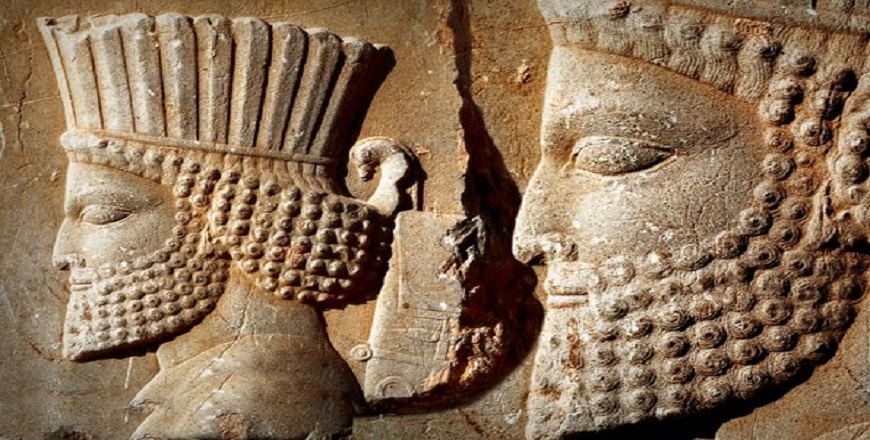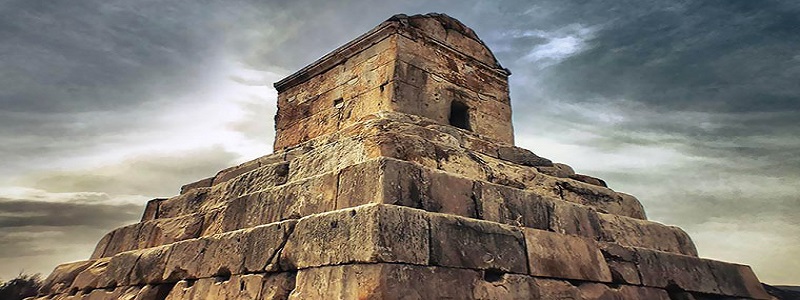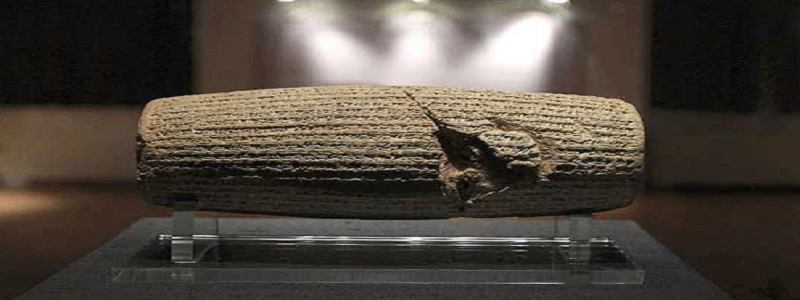

In ancient history, Iran was known both as a land and a people, though it is not likely that the empire was known as such until the Sasanian period. Aryan tribes arrived in the land in the third and second millennium BC, probably in more than one wave of immigration. Nomadic Iranian tribes settled across the Iranian plateau and by the first millennium BC, Medes, Persians, Bactrians and Parthians populated the western part while the Iranian Pashtuns and Baluch began to settle on the eastern edge, on the mountainous frontier of north-western India and into what is now Baluchistan. There were still other Iranian peoples, such as the Scythian and Alan tribes, the former later harassing various Persian empires with their border raids.
Ancient Persian history begins with the creation of the first world empire by Cyrus the Great of the Achaemenids over two and half thousand years ago. This empire did not remain as glorious as it was under Cyrus and his successor, Darius, but it was still the greatest world empire when it was defeated and conquered by Alexander, characteristically within a short period of time in 330 BC.
The Seleucid empire established after Alexander’s death introduced aspects of Greek culture to Persian lands but not sufficiently deeply for them to take strong root in subsequent cultural developments. From 247 BC onwards Parthian Iranians of the north-east began to form a state, although it took another century for the Arascid empire to come fully into its own. Nevertheless, a certain degree of Hellenism survived under the Arsacids, who were in turn overthrown in 224 AD by Ardeshir Babakan, founder of the Sassanian dynasty, once again with typical swiftness. The Sassanians were ethically Persian and, having risen from Persis (Pars) , tried to reconstruct the traditional Persian empire, though it was not as vast and powerful as that of the Achaemenids. More than four centuries later they were overthrown by Muslim Arabs, again in a relatively short period of time.

Cyrus the great
Cyrus (559-529) united the Medes and the Persians in 550 BC. Herodotus tells the legend that after the birth of Cyrus, Astyages had a dream which his magi interpreted to mean that his grandson would eventually overthrow him. He then ordered his steward to kill the infant boy. This the steward felt he could not do and so asked herdsman to do it for him; but the latter kept the child and brought him up as his own. When Cyrus was ten years old, it appeared from his attitude and behavior that he could not be a common man’s son. His suspicions aroused. Astyages talked to the old steward, who confessed that he had not killed the boy. Angered, the king tricked him into eating his own son’s flesh but allowed Cyrus to return to his biological parents, Cambyses and Mandana. This is clearly a legend, the likes of which have been told about other legendary and historical figures, but may not be entirely without historical interest.
Cyrus succeeded his father to the throne of Anshan and Persis in 559. There are various legends about the causes of Cyrus’ revolt in 553 against his grandfather and overlord. But the fact that the Medinas of all ranks welcomed it and the Babylonians had broken their tie with the Medes played a crucial role. Having conquered the Medes, Cyrus then set on a career of conquest, and by 530, the year of his death, he had created the first world empire. Next he attacked and conquered Lydia and much of Asia Minor, including some of its Greek cities. Traditionally the date of the conquest of Lydia was believed to be 547, but more recent scholarship has cast doubt on this.
A few years later he turned his attention to the east to secure his eastern frontiers from nomadic incursion, conquering vast territories including Hyrcania, Parthia and Soghdiana up to the River Jaxartes (Seyhun or Syr Darya), which flows into the Aral sea. Cyrus introduced agriculture in these regions and built fortress towns – of which the most famous now is the city of Samarkand in Uzbekistan – to defend the north-eastern part of his empire against the attacks of central Asian nomads.
But the jewel in his imperial crown came with the conquest of Babylonia in 539, which was the oldest surviving civilization in the region and included Mesopotamia, Syria and Phoenicia. The fairness and moderation with which Cyrus treated the conquered people is a legendry. The Cyrus Cylinder, now in the British Museum, on which is proclaimed the freedom of his subject peoples in matters of religion and culture, is sometimes described as the first charter of human rights. While “human rights” is a modern concept that is no more than two centuries old – dating back to the American and French Revolutions – the appellation may be relevant to the extent that it highlights moderation and toleration by a supreme overlord in generally immoderate and intolerant age. Cyrus demonstrably respected the god Bel (Marduk) of the Babylonians, and famously released the Jewish people from captivity and ordered the temple at Jerusalem to be rebuilt.
When he began his conquests, his capital was Ansha, making Ecbatana his second capital after he had extended his rule to Media. In another capital, Babylon, he was officially and ceremoniously invested as king, but he lived in all of these cities at different times. He founded his own new and entirely Persian capital, Pasargadae, which may have meant “the camp of the Persians” some 150 kilometers north-east of the modern city of Shiraz. Its construction begun in 546 BC or later, and it was not yet finished when Cyrus died in 530 or 529, remaining the Persians capital until Darius began building another in Persepolis.

The archaeological site covers 1.6 kilometers and includes the tomb of Cyrus, its greatest surviving monuments, the fortress of Tall-e-Takht sitting on the nearby hill and the remains of two royal palaces and gardens. Carved above the gate was a message in Old Persian, Elamite and Babylonian: “I, Cyrus, the king, an Achaemenian.” The gardens are the earliest known example of the Persian “Chahar Bagh”, or fourfold garden design. Now in ruins, Pasargadae represented Persian art at its best in this period. Architectural and decorative borrowings from Babylonia, Egypt and other foreign lands were infused with indigenous Iranian art to produce a unique composite effect, an artistic wonder that some scholars have put above even the much more majestic and complete complex at Persepolis.
Traditions about how Cyrus died are varied. According to Herodotus, he was killed in a battle as he rushed east to face intruding nomads of Iranian origin; Xenophon believed that he died of natural causes; and according to yet another tradition he was mortally wounded during an expedition to the Far East. He had already made his first Cambyses king of Babylon and charged him with preparations for an invasion of Egypt, while his younger son, Bardiya, was in charge of the eastern provinces. Before setting out for Egypt in 525, Cambyses had his brother secretly murdered, apparently from the fear that he might revolt in his absence. He conquered Egypt and was believed to have displayed religious and cultural intolerance towards the Egyptians, although recent research has tended to modify that belief. Meanwhile, he heard that back in Persia an imposter had claimed to Bardiya and had usurped the throne. It was while rushing back from Egypt that he died, perhaps by accidentaly wounding himself with his own sword, deliberately committing suicide or in some other way... Read more